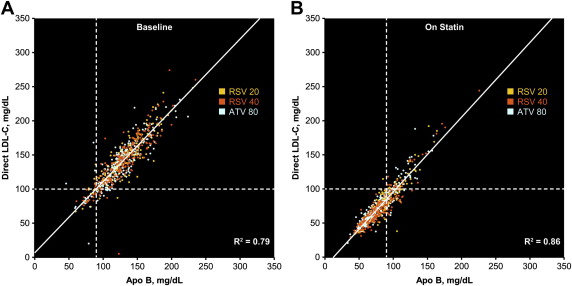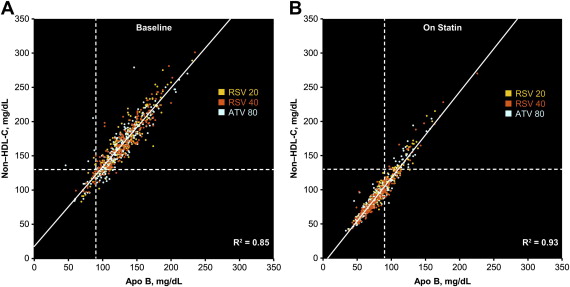The low-density lipoprotein (LDL) cholesterol goal of <70 mg/dl, recommended for patients with acute coronary syndrome, typically requires intensive therapy with high-dose statins. The secondary goals of non−high-density lipoprotein (non-HDL) cholesterol <100 mg/dl and apolipoprotein B (ApoB) <80 mg/dl have been recommended to reduce excess cardiovascular risk not captured by LDL cholesterol. The present post hoc analysis from the Limiting UNdertreatment of lipids in Acute coronary syndrome with Rosuvastatin (LUNAR) study examined the relation of ApoB with LDL cholesterol and non-HDL cholesterol at baseline and during treatment with intensive statin therapy. The LUNAR participants had acute coronary syndrome and received rosuvastatin 40 mg/day or 20 mg/day or atorvastatin 80 mg/day for 12 weeks. Linear regression analyses were used to compare ApoB, direct LDL cholesterol, and non-HDL cholesterol at baseline and during therapy. Of the 682 patients included in the analysis, 220 had triglycerides ≥200 mg/dl. Linear regression analysis showed that correlation of ApoB and non-HDL cholesterol was stronger than that of ApoB and LDL cholesterol and stronger with statin therapy than at baseline (R 2 = 0.93 for ApoB vs non-HDL cholesterol with statins). The target of ApoB of 80 mg/dl correlated with LDL cholesterol of 90 mg/dl and non-HDL cholesterol of 110 mg/dl at baseline and with LDL cholesterol of 74 mg/dl and non-HDL cholesterol of 92 mg/dl with statin therapy. For high-triglyceride patients, the corresponding on-treatment targets were LDL cholesterol of 68 mg/dl and non-HDL cholesterol of 92 mg/dl. In conclusion, non-HDL cholesterol is an adequate surrogate of ApoB during statin therapy, independent of triglyceride status. However, to match LDL cholesterol and ApoB treatment goals in the very-high-risk category, the current non-HDL cholesterol goal should be lowered by 8 to 10 mg/dl.
Patients with acute coronary syndrome (ACS), defined as any constellation of symptoms suggesting acute myocardial ischemia, including myocardial infarction and unstable angina pectoris, are at very high risk of adverse cardiovascular outcomes and generally require intensive lipid-lowering therapy to achieve adequate risk reduction. For this patient population, both the American Diabetes Association/American College of Cardiology and European Society of Cardiology/European Atherosclerosis Society guidelines on lipid management recommend low-density lipoprotein (LDL) cholesterol <70 mg/dl as the primary treatment target, with non–high-density lipoprotein (non-HDL) cholesterol <100 mg/dl and apolipoprotein B (ApoB) <80 mg/dl as secondary targets. Although the targets for stable patients with coronary artery disease are LDL cholesterol <100 mg/dl, non-HDL cholesterol <130 mg/dl, and ApoB <90 or <100 mg/dl, ACS requires more intensive therapy to achieve adequate risk reduction. The present post hoc analysis of data from the Limiting UNdertreatment of lipids in ACS with Rosuvastatin (LUNAR) trial examined how intensive statin therapy in patients with ACS affects the relations between ApoB and LDL cholesterol and between ApoB and non-HDL cholesterol. Specifically, the present analysis sought to determine the LDL cholesterol and non-HDL cholesterol levels in patients with ACS receiving high-dose statin therapy that would have to be achieved to meet ApoB targets of 80 mg/dl or 90 mg/dl.
Methods
The LUNAR trial was a prospective, multicenter (169 sites), randomized, open-label, 3-arm, parallel-group phase IIIb study (AstraZeneca study D3560L00021 [4522US/0001]; www.clinicaltrials.gov identifier NCT00214630 ). The study design and patient selection criteria have been previously reported. In brief, LUNAR participants were men and women aged 18 to 75 years with LDL cholesterol >70 mg/dl and fasting triglycerides (TG) <500 mg/dl who had been hospitalized for ACS within 48 hours after the initial symptoms. Eligible patients had unstable angina pectoris, had ST-segment elevation myocardial infarction but underwent successful reperfusion therapy within 12 hours after symptom onset, or had non–ST-segment elevation myocardial infarction. Patients received rosuvastatin 20 mg/day, rosuvastatin 40 mg/day, or atorvastatin 80 mg/day for 12 weeks.
Baseline lipids were measured after the patients had fasted overnight. Lipid levels during therapy were measured 6 and 12 weeks after the initiation of statin therapy. On-statin lipid values represented the average of 2 measurements at weeks 6 and 12. Serum levels of LDL cholesterol were measured using the Direct LDL-C Plus process. The distribution of values of LDL cholesterol and non-HDL cholesterol as a function of ApoB levels was examined before and after statin therapy, with a focus on the average values necessary to achieve the specific target levels of ApoB. The associations between lipid parameters and ApoB were assessed by linear regression analysis for all evaluable patients and for subgroups defined by normal (<200 mg/dl) and high (≥200 mg/dl) baseline TG values.
Results
Of the 825 patients with ACS randomized for statin treatment, 682 (82.7%) had evaluable ApoB, non-HDL cholesterol, and direct LDL cholesterol values available at baseline and after 6 and/or 12 weeks of statin therapy. Of those, most were men, most were white, and most were aged <65 years ( Table 1 ). Obesity, defined as a body mass index >30 kg/m 2 , was common (41%). Approximately 1/3 of the evaluable patients (32.3%) had a baseline TG level of ≥200 mg/dl. The mean baseline values for direct LDL cholesterol, non-HDL cholesterol, and ApoB were 140.9, 166.8, and 128.6 mg/dl, respectively.
| Characteristic | Patients (n = 682) |
|---|---|
| Age (yrs) | 53.2 ± 9.1 |
| <65 yrs | 603 (88%) |
| Gender | |
| Women | 163 (24%) |
| Men | 519 (76%) |
| Race | |
| White | 553 (81%) |
| Black | 79 (12%) |
| Hispanic | 33 (5%) |
| Asian | 3 (0.4%) |
| Other | 14 (2%) |
| Body mass index (kg/m 2 ) | 30.1 ± 5.8 |
| ≥30 kg/m 2 | 280 (41%) |
| Acute coronary syndrome | |
| ST-segment elevation myocardial infarction | 264 (39%) |
| Non–ST-segment elevation myocardial infarction | 245 (36%) |
| Unstable angina pectoris | 173 (25%) |
| Triglycerides ≥200 mg/dl | 220 (32.3%) |
| Baseline lipid values (mg/dl) | |
| Low-density lipoprotein cholesterol | 140.9 ± 33.1 |
| Non–high-density lipoprotein cholesterol | 166.8 ± 35.6 |
| Apolipoprotein B | 128.6 ± 28.3 |
| High-density lipoprotein cholesterol | 39.8 ± 10.0 |
Figures 1 and 2 show the results of regression analyses examining the relation of ApoB to direct LDL cholesterol and non-HDL cholesterol at baseline and during statin therapy. The correlation of ApoB with LDL cholesterol at baseline (R 2 = 0.79; Figure 1 ) was strengthened by statin therapy (R 2 = 0.86; Figure 1 ). Similarly, the correlation of ApoB with non-HDL cholesterol at baseline (R 2 = 0.85; Figure 2 ) was strengthened by statin therapy (R 2 = 0.93; Figure 2 ). The correlation of ApoB with non-HDL cholesterol was stronger than that with LDL cholesterol, both at baseline and during statin therapy, with the strongest correlation observed for the on-statin values of ApoB and non-HDL cholesterol ( Figures 1 and 2 ).


According to the regression analyses, an ApoB value of 90 mg/dl correlated with an LDL cholesterol value of 101 mg/dl at baseline and with an LDL cholesterol value of 85 mg/dl during statin therapy ( Table 2 ). The ApoB value of 80 mg/dl corresponded to LDL cholesterol values of 90 mg/dl at baseline and 74 mg/dl with statin therapy in the analysis population. Thus, the analysis predicts that patients with ACS who achieved their primary goal of LDL cholesterol <70 mg/dl with intensive statin therapy on average would also meet the secondary ApoB goal of <80 mg/dl.
| Triglycerides (mg/dl) | Patients (n) | Slope | Intercept | R 2 | LDL Cholesterol (mg/dl) ∗ | |
|---|---|---|---|---|---|---|
| ApoB 90 mg/dl | ApoB 80 mg/dl | |||||
| Baseline | ||||||
| <200 | 462 | 1.12 | −0.4 | 0.83 | 100.7 | 89.5 |
| ≥200 | 220 | 1.03 | +2.0 | 0.75 | 95.1 | 84.7 |
| All patients | 682 | 1.04 | +6.6 | 0.79 | 100.5 | 90.1 |
| During statin therapy | ||||||
| <200 | 462 | 1.17 | −16.9 | 0.89 | 88.5 | 76.8 |
| ≥200 | 220 | 1.06 | −16.1 | 0.88 | 79.0 | 68.4 |
| All patients | 682 | 1.09 | −13.6 | 0.86 | 84.9 | 73.9 |
Stay updated, free articles. Join our Telegram channel

Full access? Get Clinical Tree


